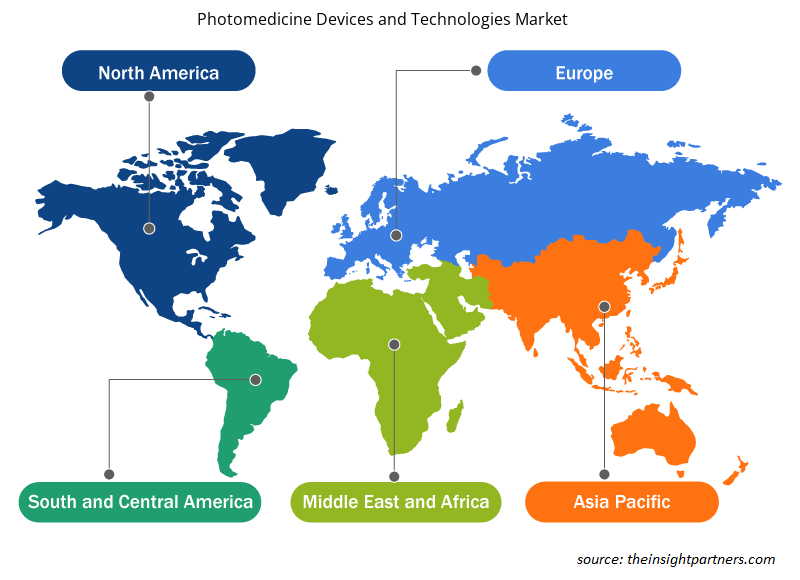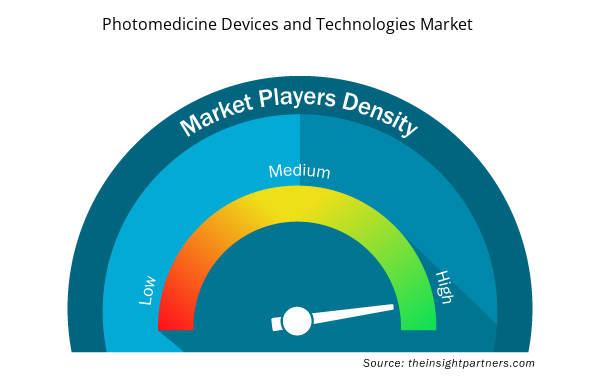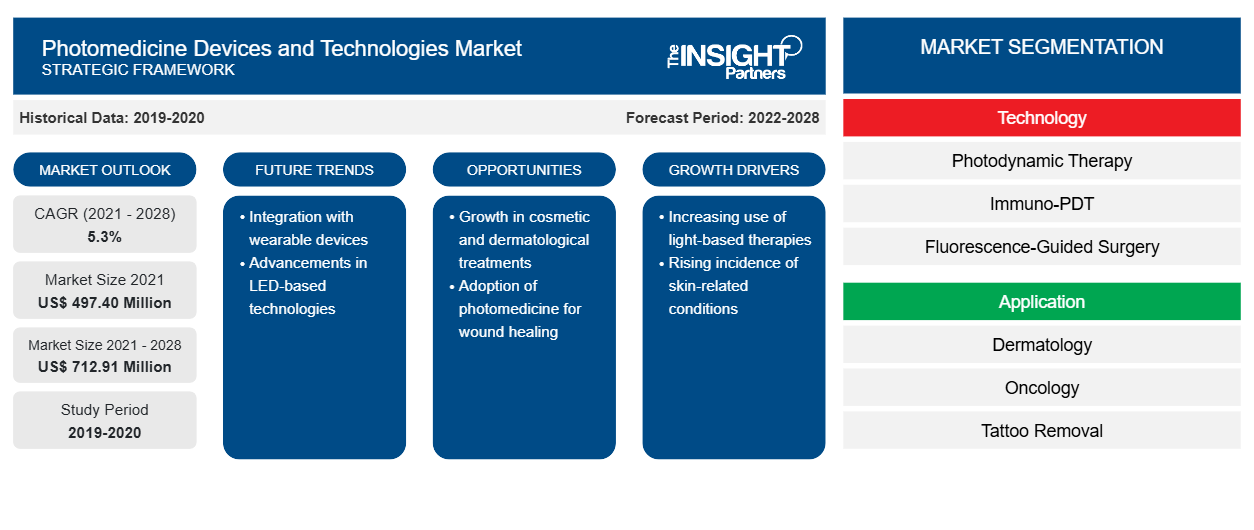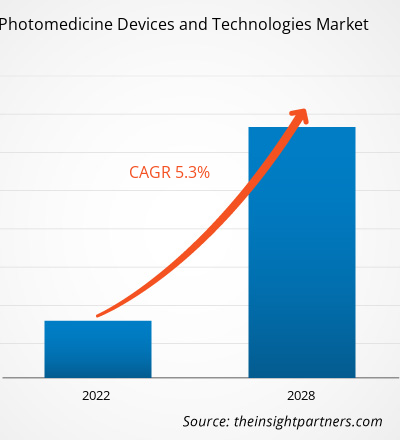Se proyecta que el mercado de dispositivos y tecnologías de fotomedicina alcance los US$ 712,91 millones para 2028 desde los US$ 497,40 millones en 2021; se estima que crecerá a una CAGR del 5,3% entre 2021 y 2028.
La fotomedicina es una disciplina de la medicina que utiliza la fotobiología y la luz para curar enfermedades y otras afecciones médicas. En este tratamiento se utilizan láseres, luz de espectro completo, lámparas dicroicas, luz polarizada policromática, diodos emisores de luz y lámparas fluorescentes para exponer a las personas a longitudes de onda de luz específicas. La fotomedicina es una nueva opción terapéutica para una variedad de trastornos que ha superado a la antigua técnica de diagnóstico y detección de una afección. Factores como una aplicabilidad más amplia de la fotomedicina y el aumento de la demanda de terapias mínimamente invasivas y no invasivas están impulsando el crecimiento del mercado de dispositivos y tecnologías de fotomedicina . Sin embargo, el estricto marco regulatorio para las tecnologías de fotomedicina obstaculiza el crecimiento del mercado.
Perspectivas del mercado
El aumento de la demanda de terapias mínimamente invasivas y no invasivas impulsa el crecimiento del mercado de dispositivos y tecnologías de fotomedicina
La popularidad de los procedimientos médicos mínimamente invasivos ha aumentado en los últimos años, debido a que implican pequeñas incisiones, una recuperación más rápida de los pacientes y una menor incomodidad para ellos. Además, los procedimientos de fotomedicina ofrecen beneficios como menos dolor; menos traumatismo en músculos, nervios, tejidos y órganos; menos sangrado y cicatrices; y lesiones mínimas en los tejidos. Según la Sociedad Estadounidense de Cirujanos Plásticos, en 2020 se realizaron más de 15,6 millones de procedimientos cosméticos mínimamente invasivos en los EE. UU. En 2020, se realizaron un total de 13 281 235 procedimientos cosméticos mínimamente invasivos. Entre los 5 procedimientos cosméticos mínimamente invasivos más importantes, el tratamiento con luz pulsada intensa (IPL) ha sustituido al tratamiento de depilación láser, registrándose más de 827 000 procedimientos IPL realizados en 2020. Según un informe mundial publicado por la Sociedad Internacional de Cirugía Plástica Estética (ISAPS), el número de procedimientos estéticos y cosméticos realizados en todo el mundo aumentó de 20 236 901 en 2014 a 23 266 374 en 2018.
Personalice este informe según sus necesidades
Obtendrá personalización en cualquier informe, sin cargo, incluidas partes de este informe o análisis a nivel de país, paquete de datos de Excel, así como también grandes ofertas y descuentos para empresas emergentes y universidades.
- Obtenga las principales tendencias clave del mercado de este informe.Esta muestra GRATUITA incluirá análisis de datos, desde tendencias del mercado hasta estimaciones y pronósticos.
Perspectivas basadas en la tecnología
Según la tecnología, el mercado de dispositivos y tecnologías de fotomedicina se segmenta en terapia fotodinámica (TFD), inmunoterapia TFD (terapias fotoinmunes), cirugía guiada por fluorescencia, diagnóstico fotodinámico, fotobiomodulación (luces láser) y otras tecnologías. El segmento de terapia fotodinámica tuvo la mayor participación del mercado en 2021 y se espera que registre la CAGR más alta durante el período de pronóstico.
Perspectivas basadas en aplicaciones
Según la aplicación, el mercado de dispositivos y tecnologías de fotomedicina se segmenta en estética y dermatología, oncología, oftalmología, neurología, manejo del dolor, cicatrización de heridas y otras aplicaciones. El mercado del segmento de estética y dermatología se segmenta además en depilación, eliminación de tatuajes, rejuvenecimiento de la piel y otras aplicaciones. El segmento de estética y dermatología tuvo la mayor participación de mercado en 2021, y se espera que el mismo segmento registre la CAGR más alta del mercado durante el período de pronóstico.
Varias empresas que operan en el mercado de dispositivos y tecnologías de fotomedicina están adoptando estrategias como lanzamientos de productos, fusiones y adquisiciones, colaboraciones, innovaciones de productos y expansiones de carteras de productos para expandir su presencia en todo el mundo, mantener la marca y satisfacer la creciente demanda de los usuarios finales.
Dispositivos y tecnologías de fotomedicina
Perspectivas regionales del mercado de dispositivos y tecnologías de fotomedicina
Los analistas de Insight Partners explicaron en detalle las tendencias y los factores regionales que influyen en el mercado de dispositivos y tecnologías de fotomedicina durante el período de pronóstico. Esta sección también analiza los segmentos y la geografía del mercado de dispositivos y tecnologías de fotomedicina en América del Norte, Europa, Asia Pacífico, Oriente Medio y África, y América del Sur y Central.

- Obtenga datos regionales específicos para el mercado de dispositivos y tecnologías de fotomedicina
Alcance del informe de mercado sobre dispositivos y tecnologías de fotomedicina
| Atributo del informe | Detalles |
|---|---|
| Tamaño del mercado en 2021 | US$ 497,40 millones |
| Tamaño del mercado en 2028 | US$ 712,91 millones |
| CAGR global (2021-2028) | 5,3% |
| Datos históricos | 2019-2020 |
| Período de pronóstico | 2022-2028 |
| Segmentos cubiertos | Por tecnología
|
| Regiones y países cubiertos | América del norte
|
| Líderes del mercado y perfiles de empresas clave |
|
Densidad de actores del mercado de dispositivos y tecnologías de fotomedicina: comprensión de su impacto en la dinámica empresarial
El mercado de dispositivos y tecnologías de fotomedicina está creciendo rápidamente, impulsado por la creciente demanda de los usuarios finales debido a factores como la evolución de las preferencias de los consumidores, los avances tecnológicos y una mayor conciencia de los beneficios del producto. A medida que aumenta la demanda, las empresas amplían sus ofertas, innovan para satisfacer las necesidades de los consumidores y aprovechan las tendencias emergentes, lo que impulsa aún más el crecimiento del mercado.
La densidad de actores del mercado se refiere a la distribución de las empresas o firmas que operan dentro de un mercado o industria en particular. Indica cuántos competidores (actores del mercado) están presentes en un espacio de mercado determinado en relación con su tamaño o valor total de mercado.
Las principales empresas que operan en el mercado de dispositivos y tecnologías de fotomedicina son:
- Láseres Alma
- Beurer GmbH
- Biolitec AG
- Lumenis
- Quantel Médico
Descargo de responsabilidad : Las empresas enumeradas anteriormente no están clasificadas en ningún orden particular.

- Obtenga una descripción general de los principales actores clave del mercado de dispositivos y tecnologías de fotomedicina
Mercado de dispositivos y tecnologías de fotomedicina – por tecnología
- Terapia fotodinámica (TFD)
- Inmuno-TFD (terapias fotoinmunes)
- Cirugía guiada por fluorescencia
- Diagnóstico fotodinámico
- Fotobiomodulación (Luces Láser)
- Otras tecnologías
Mercado de dispositivos y tecnologías de fotomedicina: por aplicación
- Estética y Dermatología
- Depilación
- Eliminación de tatuajes
- Rejuvenecimiento de la piel
- Otras aplicaciones
- Oncología
- Oftalmología
- Neurología
- Manejo del dolor
- Cicatrización de heridas
- Otras aplicaciones
Mercado de dispositivos y tecnologías de fotomedicina por geografía
- América del norte
- A NOSOTROS
- Canadá
- México
- Europa
- Francia
- Alemania
- Italia
- Reino Unido
- España
- Resto de Europa
- Asia Pacífico (APAC)
- Porcelana
- India
- Corea del Sur
- Japón
- Australia
- Resto de Asia Pacífico
- Oriente Medio y África (MEA)
- Sudáfrica
- Arabia Saudita
- Emiratos Árabes Unidos
- Resto de Oriente Medio y África
- América del Sur (SAM)
- Brasil
- Argentina
- Resto de América del Sur y Central
Perfiles de empresas
- Láseres Alma
- Beurer GmbH
- Biolitec AG
- Lumenis
- Quantel Médico
- THOR Fotomedicina Ltd.
- Verilux Inc
- Candela Médica
- CONFIANZA PHILIPS NV
- Corporación Iridex
- Análisis histórico (2 años), año base, pronóstico (7 años) con CAGR
- Análisis PEST y FODA
- Tamaño del mercado Valor/volumen: global, regional, nacional
- Industria y panorama competitivo
- Conjunto de datos de Excel



Report Coverage
Revenue forecast, Company Analysis, Industry landscape, Growth factors, and Trends

Segment Covered
This text is related
to segments covered.

Regional Scope
North America, Europe, Asia Pacific, Middle East & Africa, South & Central America

Country Scope
This text is related
to country scope.
Preguntas frecuentes
Global photomedicine devices and technologies market is segmented by region into North America, Europe, Asia Pacific, Middle East & Africa and South & Central America. In North America, the U.S. is the largest market for photomedicine devices and technologies. The US is estimated to hold the largest share in the photomedicine devices and technologies market during the forecast period. Whereas, Asia Pacific is the fastest growing region during the forecast period with highest CAGR rate of 6.1%. The growth of Asia Pacific photomedicine devices and technologies market is owing to, increasing burden of chronic diseases such as cancer, rise in demand for minimally invasive surgical procedures and growing adoption of photomedicine.
The photomedicine devices and technologies market majorly consists of the players such as Alma Lasers, Beurer GmbH., Biolitec AG, Lumenis, Quantel Medical, THOR Photomedicine Ltd, Verilux Inc, Candela Medical, KONINKLIJKE PHILIPS N.V., and Iridex Corporation, among others
The photodynamic therapy segment dominated the global photomedicine devices and technologies market and held the largest revenue share of 24.82% in 2021.
The aesthetics and dermatology segment dominated the global photomedicine devices and technologies market and accounted for the largest revenue share of 27.72% in 2021.
Photomedicine is a discipline of medicine that uses photobiology and light to cure diseases and other medical conditions. Photomedicine is the use of lasers, full-spectrum light, dichroic lamps, polychromatic polarized light, light-emitting diodes, and fluorescent lamps to expose people to specific wavelengths of light. Photomedicine is a new therapy option for a variety of disorders that has outperformed the old technique of diagnosing and detecting a condition.
Key factors that are driving the growth of this market are wider applicability of photomedicine and rise in demand for minimally invasive and non-invasive therapies.
Trends and growth analysis reports related to Life Sciences : READ MORE..
The List of Companies - Photomedicine Devices and Technologies Market
- Alma Lasers
- Beurer GmbH
- Biolitec AG
- Lumenis
- Quantel Medical
- THOR Photomedicine Ltd
- Verilux Inc
- Candela Medical
- KONINKLIJKE PHILIPS N.V
- Iridex Corporation
The Insight Partners performs research in 4 major stages: Data Collection & Secondary Research, Primary Research, Data Analysis and Data Triangulation & Final Review.
- Data Collection and Secondary Research:
As a market research and consulting firm operating from a decade, we have published and advised several client across the globe. First step for any study will start with an assessment of currently available data and insights from existing reports. Further, historical and current market information is collected from Investor Presentations, Annual Reports, SEC Filings, etc., and other information related to company’s performance and market positioning are gathered from Paid Databases (Factiva, Hoovers, and Reuters) and various other publications available in public domain.
Several associations trade associates, technical forums, institutes, societies and organization are accessed to gain technical as well as market related insights through their publications such as research papers, blogs and press releases related to the studies are referred to get cues about the market. Further, white papers, journals, magazines, and other news articles published in last 3 years are scrutinized and analyzed to understand the current market trends.
- Primary Research:
The primarily interview analysis comprise of data obtained from industry participants interview and answers to survey questions gathered by in-house primary team.
For primary research, interviews are conducted with industry experts/CEOs/Marketing Managers/VPs/Subject Matter Experts from both demand and supply side to get a 360-degree view of the market. The primary team conducts several interviews based on the complexity of the markets to understand the various market trends and dynamics which makes research more credible and precise.
A typical research interview fulfils the following functions:
- Provides first-hand information on the market size, market trends, growth trends, competitive landscape, and outlook
- Validates and strengthens in-house secondary research findings
- Develops the analysis team’s expertise and market understanding
Primary research involves email interactions and telephone interviews for each market, category, segment, and sub-segment across geographies. The participants who typically take part in such a process include, but are not limited to:
- Industry participants: VPs, business development managers, market intelligence managers and national sales managers
- Outside experts: Valuation experts, research analysts and key opinion leaders specializing in the electronics and semiconductor industry.
Below is the breakup of our primary respondents by company, designation, and region:

Once we receive the confirmation from primary research sources or primary respondents, we finalize the base year market estimation and forecast the data as per the macroeconomic and microeconomic factors assessed during data collection.
- Data Analysis:
Once data is validated through both secondary as well as primary respondents, we finalize the market estimations by hypothesis formulation and factor analysis at regional and country level.
- Macro-Economic Factor Analysis:
We analyse macroeconomic indicators such the gross domestic product (GDP), increase in the demand for goods and services across industries, technological advancement, regional economic growth, governmental policies, the influence of COVID-19, PEST analysis, and other aspects. This analysis aids in setting benchmarks for various nations/regions and approximating market splits. Additionally, the general trend of the aforementioned components aid in determining the market's development possibilities.
- Country Level Data:
Various factors that are especially aligned to the country are taken into account to determine the market size for a certain area and country, including the presence of vendors, such as headquarters and offices, the country's GDP, demand patterns, and industry growth. To comprehend the market dynamics for the nation, a number of growth variables, inhibitors, application areas, and current market trends are researched. The aforementioned elements aid in determining the country's overall market's growth potential.
- Company Profile:
The “Table of Contents” is formulated by listing and analyzing more than 25 - 30 companies operating in the market ecosystem across geographies. However, we profile only 10 companies as a standard practice in our syndicate reports. These 10 companies comprise leading, emerging, and regional players. Nonetheless, our analysis is not restricted to the 10 listed companies, we also analyze other companies present in the market to develop a holistic view and understand the prevailing trends. The “Company Profiles” section in the report covers key facts, business description, products & services, financial information, SWOT analysis, and key developments. The financial information presented is extracted from the annual reports and official documents of the publicly listed companies. Upon collecting the information for the sections of respective companies, we verify them via various primary sources and then compile the data in respective company profiles. The company level information helps us in deriving the base number as well as in forecasting the market size.
- Developing Base Number:
Aggregation of sales statistics (2020-2022) and macro-economic factor, and other secondary and primary research insights are utilized to arrive at base number and related market shares for 2022. The data gaps are identified in this step and relevant market data is analyzed, collected from paid primary interviews or databases. On finalizing the base year market size, forecasts are developed on the basis of macro-economic, industry and market growth factors and company level analysis.
- Data Triangulation and Final Review:
The market findings and base year market size calculations are validated from supply as well as demand side. Demand side validations are based on macro-economic factor analysis and benchmarks for respective regions and countries. In case of supply side validations, revenues of major companies are estimated (in case not available) based on industry benchmark, approximate number of employees, product portfolio, and primary interviews revenues are gathered. Further revenue from target product/service segment is assessed to avoid overshooting of market statistics. In case of heavy deviations between supply and demand side values, all thes steps are repeated to achieve synchronization.
We follow an iterative model, wherein we share our research findings with Subject Matter Experts (SME’s) and Key Opinion Leaders (KOLs) until consensus view of the market is not formulated – this model negates any drastic deviation in the opinions of experts. Only validated and universally acceptable research findings are quoted in our reports.
We have important check points that we use to validate our research findings – which we call – data triangulation, where we validate the information, we generate from secondary sources with primary interviews and then we re-validate with our internal data bases and Subject matter experts. This comprehensive model enables us to deliver high quality, reliable data in shortest possible time.


 Obtenga una muestra gratuita de este informe
Obtenga una muestra gratuita de este informe